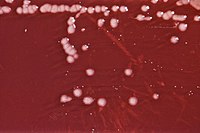
Photo from wikipedia
The repurposing of gallium nitrate as an antibacterial, a drug used previously for the treatment of hypercalcemia, is a plausible alternative to combat infections by Pseudomonas aeruginosa, since it has… Click to show full abstract
The repurposing of gallium nitrate as an antibacterial, a drug used previously for the treatment of hypercalcemia, is a plausible alternative to combat infections by Pseudomonas aeruginosa, since it has antipseudomonal properties in vitro and in vivo in animal models and in human lung infections. Furthermore, gallium nitrate tolerance in clinical isolates is very rare. Nevertheless, studies on the reference strains PA14 and PAO1 show that resistance against gallium nitrate is achieved by decreasing gallium intracellular levels by increasing the production of pyocyanin. In this work, we induced resistance in a cystic fibrosis P. aeruginosa isolate and explored its resistance mechanisms. This isolated strain, INP-58M, was not a pyocyanin producer, and its pyoverdine levels remained unchanged upon gallium addition. However, it showed higher activities of NADPH-producing enzymes and the antioxidant enzyme SOD when gallium was added, which suggests a better antioxidant response. Remarkably, gallium intracellular levels in the resistant isolate were higher than those of the parental strain at 20 h but lower after 24 h of culture, suggesting that this strain is capable of gallium efflux.
Journal Title: Archives of Microbiology
Year Published: 2019
Link to full text (if available)
Share on Social Media: Sign Up to like & get
recommendations!